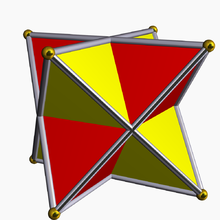In projective geometry, a desmic system (from Greek δεσμός 'band, chain') is a set of three tetrahedra in 3-dimensional projective space, such that any two are desmic (related such that each edge of one cuts a pair of opposite edges of the other). It was introduced by Stephanos (1879). The three tetrahedra of a desmic system are contained in a pencil of quartic surfaces.


Every line that passes through two vertices of two tetrahedra in the system also passes through a vertex of the third tetrahedron. The 12 vertices of the desmic system and the 16 lines formed in this way are the points and lines of a Reye configuration.
Example
editThe three tetrahedra given by the equations
form a desmic system, contained in the pencil of quartics
for a + b + c = 0.
References
edit- Borwein, Peter B (1983), "The Desmic conjecture", Journal of Combinatorial Theory, Series A, 35 (1): 1–9, doi:10.1016/0097-3165(83)90022-5, MR 0704251.
- Hudson, R. W. H. T. (1990), Kummer's quartic surface, Cambridge Mathematical Library, Cambridge University Press, ISBN 978-0-521-39790-2, MR 1097176.
- Stephanos, Cyparissos (1879), "Sur les systèmes desmiques de trois tétraèdres", Bulletin des sciences mathématiques et astronomiques, Série 2, 3 (1): 424–456, JFM 11.0431.01.